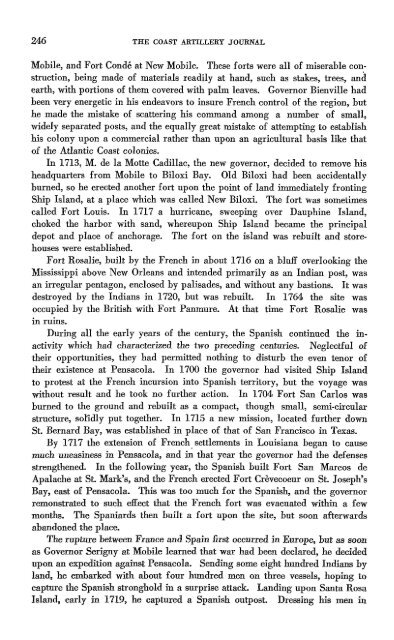THE COAST ARTILLERY JOURNAL - Air Defense Artillery
THE COAST ARTILLERY JOURNAL - Air Defense Artillery
THE COAST ARTILLERY JOURNAL - Air Defense Artillery
You also want an ePaper? Increase the reach of your titles
YUMPU automatically turns print PDFs into web optimized ePapers that Google loves.
246 <strong>THE</strong> <strong>COAST</strong> <strong>ARTILLERY</strong> <strong>JOURNAL</strong><br />
Mobile, and Fort Conde at New Mobile. These forts were all of miserable construction,<br />
being made of materials readily at hand, such as stakes, trees, and<br />
earth, with portions of them covered with palm leaves. Governor Bienville had<br />
been very energetic in his endeavors to insure French control of the region, but<br />
he made the mistake of scattering his command among a number of small,<br />
widely separated posts, and the equally great mistake of attempting to establish<br />
his colony upon a commercial rather than upon an agricultural basis like that<br />
of the Atlantic Coast colonies.<br />
In 1713, M. de la Motte Cadillac, the new governor, decided to remove his<br />
headquarters from Mobile to Biloxi Bay. Old Biloxi had been accidentally<br />
burned, so he erected another fort upon the point of land ill1ll1ediatelyfronting<br />
Ship Island, at a place which was called New Biloxi. The fort was sometimes<br />
called Fort Louis. In 1717 a hurricane, sweeping over Dauphine Island,<br />
choked the harbor with sand, whereupon Ship Island became the principal<br />
depot and place of anchorage. The fort on the island was rebuilt and storehouses<br />
were established.<br />
Fort Rosalie, built by the French in about 1716 on a bluff overlooking the<br />
Mississippi above New Orleans and intended primarily as an Indian post, was<br />
an irregular pentagon, enclosed by palisades, and without any bastions. It was<br />
destroyed by the Indians in 1720, but was rebuilt. In 1764 the site was<br />
occupied by the British with Fort Panmure. At that time Fort Rosalie was<br />
in ruins.<br />
During all the early years of the century, the Spanish continued the inactivity<br />
which had characterized the two preceding centuries. Neglectful of<br />
their opportunities, they had permitted nothing to disturb the even tenor of<br />
their existence at Pensacola. In 1700 the governor had visited Ship Island<br />
to protest at the French incursion into Spanish territory, but the voyage was<br />
without result and he took no further action. In 1704 Fort San Carlos was<br />
burned to the ground and rebuilt as a compact, though small, semi-circular<br />
structure, solldly put together. In 1715 a new mission, located further down<br />
St. Bernard Bay, was established in place of that of San Francisco in Texas.<br />
By 1717 the extension of French. settlements in Louisiana began to cause<br />
much uneasiness in Pensacola, and in that year the governor had the defenses<br />
strengthened. In the following year, the Spanish built Fort San Marcos de<br />
Apalache at St. Mark's, and the French erected Fort Crevecoeur on St. Joseph's<br />
Bay, east of Pensacola. This was too much for the Spanish, and the governor<br />
remonstrated to such effect that the French fort was evacuated within a few<br />
months. The Spaniards then built a fort upon the site, but soon afterwards<br />
abandoned the place.<br />
The rupture between France and Spain first occurred in Europe, but as soon<br />
as Governor Serigny at Mobile learned that war had been declared, he decided<br />
upon an expedition against Pensacola. Sending some eight hundred Indians by<br />
land, he embarked with about four hundred men on three vessels, hoping to<br />
capture the Spanish stronghold in a surprise attack. Landing upon Santa Rosa<br />
Island, early in 1719, he captured a Spanish outpost. Dressing his men in
















